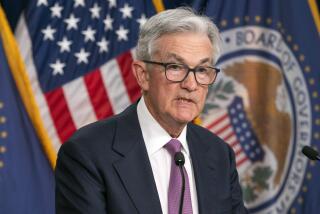After their brief flings with sitcoms and talk shows, these
WASHINGTON — The U.S. economy has performed better in the last two months than in late 2000 and consumer spending has held up stronger than expected, but the slowdown has “yet to run its full course,” Federal Reserve Chairman Alan Greenspan said Wednesday.
The Fed chairman’s remarks to a House panel suggest that although the central bank is poised to cut its benchmark interest rate as much as half a percentage point to 5% to keep the economy from sliding into a recession, policymakers may see little need to do so before their next scheduled meeting March 20.
“The exceptional degree of slowing so evident toward the end of last year seemed less evident in January and February,” Greenspan told the House Financial Services Committee.
The Fed cut its target rate for overnight loans between banks by 1 percentage point in two steps in January to 5.5% in a bid to spur the suddenly slowing economy. Speculation in recent days had another rate cut imminent as fresh readings of consumer confidence showed continued deterioration.
Yet conflicting evidence continues to turn up. A report Wednesday on manufacturing in the Midwest showed that companies were more upbeat about their prospects this month, suggesting a yearlong factory slowdown may have touched bottom in January.
The National Assn. of Purchasing Management said gains in new orders and production helped boost its monthly index of regional manufacturing to 43.2, up from an 18-year low of 40.2 in January. A reading below 50 indicates a lack of growth, however.
Meanwhile, a revision of overall U.S. economic growth in the fourth quarter showed it was even slower than the 1.4% annual rate previously reported. Gross domestic product, the total of all goods and services produced in the U.S., expanded at a 1.1% pace, the Commerce Department said.
Greenspan’s remarks disappointed investors hoping for a quick rate cut. The Dow Jones industrial average tumbled 141.60 points Wednesday while the Nasdaq fell 55.99 points.
Greenspan said Wednesday that the Fed prefers to act on monetary policy at scheduled meetings. However, he said, “We’ve also shown over the years that when we perceive actions are needed between meetings, we have no hesitancy to move.”
One more rate cut is probable, though that could be all, said Joel Naroff, president and chief economist at Naroff Economic Advisors in Holland, Pa. “The consumer will determine Fed action, and the numbers to watch are any that have to do with spending, not necessarily confidence,” Naroff said.
Greenspan’s testimony repeated most of what he said Feb. 13 before the Senate Banking Committee. He reiterated his view that the economy’s slowdown remains a greater risk than inflation. And the GDP report supported that view.
The personal consumption expenditures price index, a measure of inflation watched by Fed policymakers and tied to spending, rose at a 1.9% annual pace in the fourth quarter, close to the 1.8% rate of the third quarter.
Greenspan said the Fed will closely watch changes in consumer confidence, “especially after the steep falloff of recent months.” On Tuesday, the Conference Board reported that consumer confidence fell for the fifth consecutive month to a nearly five-year low.
Yet he noted that consumer spending has continued to rise even as surveys show confidence has fallen.
“For now, at least, the weakness in sales of motor vehicles and homes has been modest, suggesting that consumers have retained enough confidence to make longer-term commitments,” Greenspan said.
In his economic outlook, Greenspan blamed much of the economy’s weakness on an effort by businesses to cut back quickly on production in the face of falling sales.
Although companies are working hard to bring excess inventories into better alignment with demand, Greenspan said, the process might take more time.
Excess inventories “built up in 1999 and 2000 have engendered a retrenchment that has yet to run its full course,” Greenspan said, a departure from testimony he delivered two weeks ago before the Senate.
(BEGIN TEXT OF INFOBOX / INFOGRAPHIC)
Gross Domestic Product
Percentage change from previous quarter, annualized rate:
2000 fourth quarter: 1.1%
Source: Commerce Department
More to Read
Inside the business of entertainment
The Wide Shot brings you news, analysis and insights on everything from streaming wars to production — and what it all means for the future.
You may occasionally receive promotional content from the Los Angeles Times.










